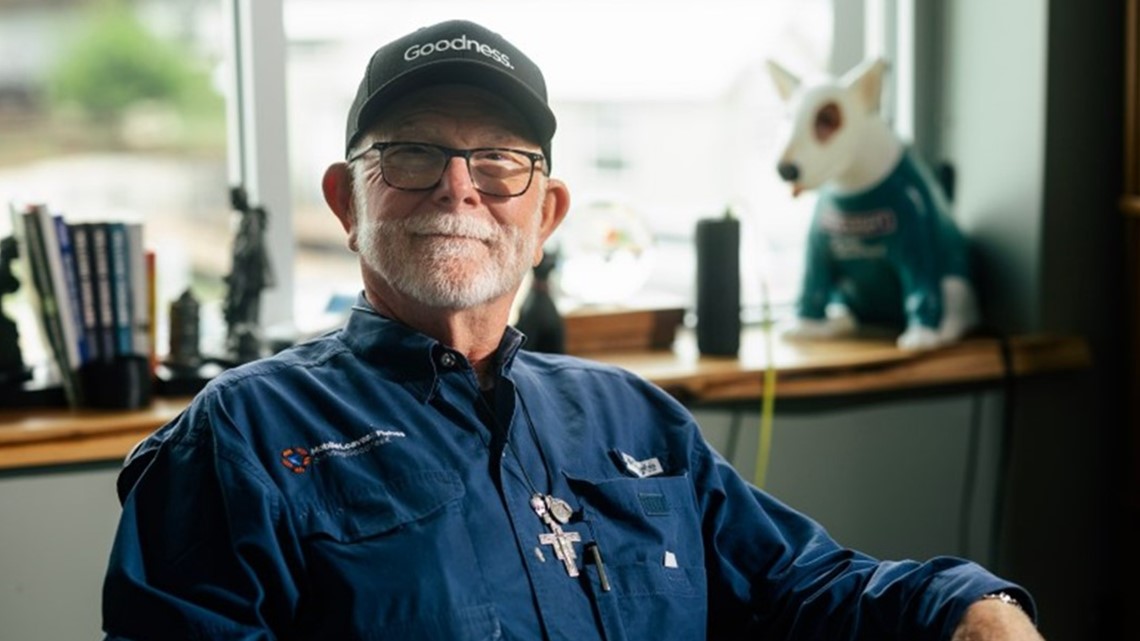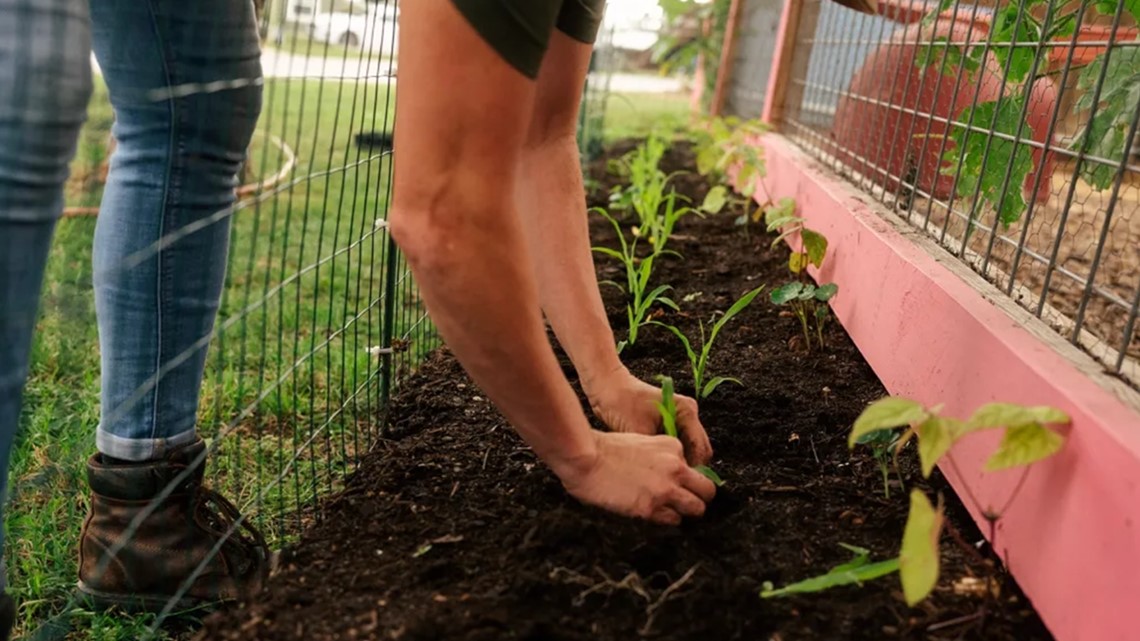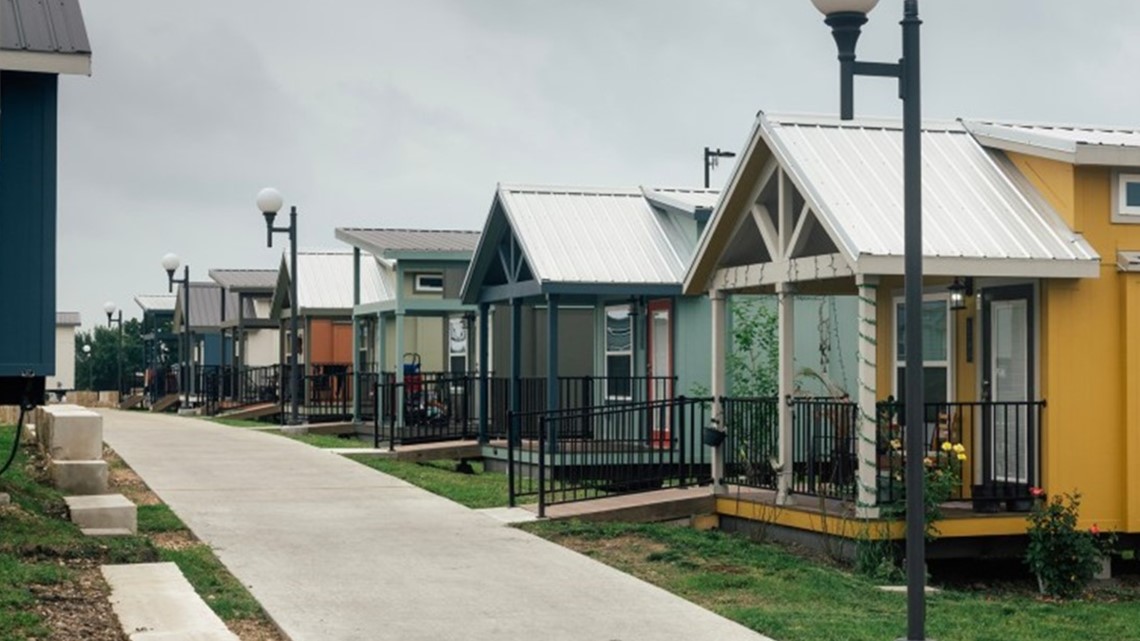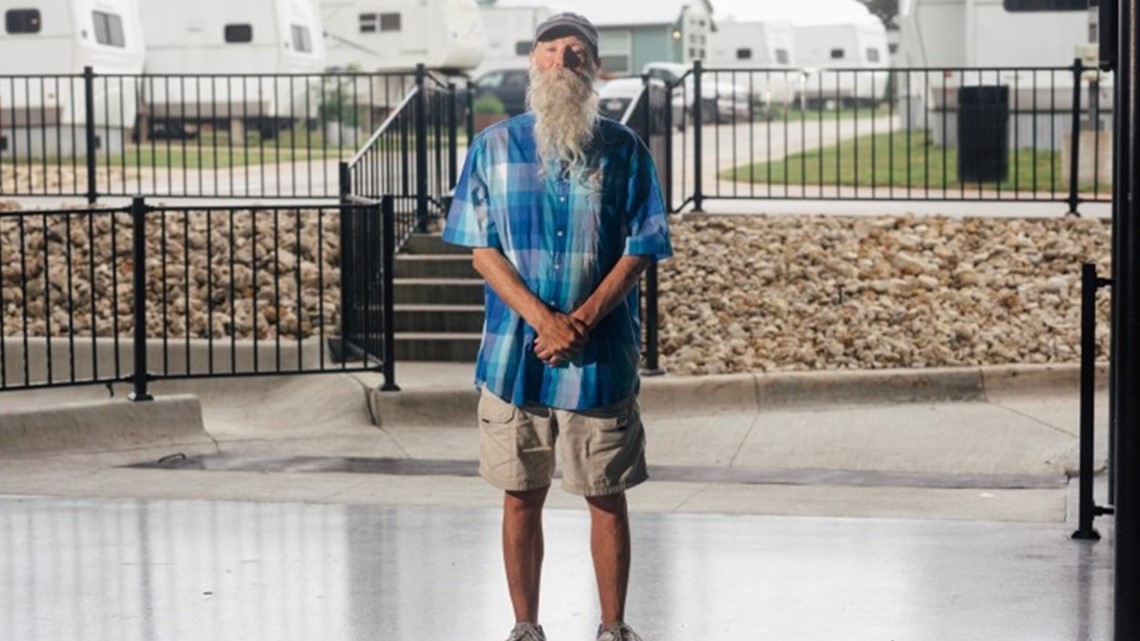CALIFORNIA, USA — This story was originally published by CalMatters.
At first glance, Community First! Village looks more like an art commune or even a high-end summer camp than what it really is: Austin’s formidable, 51-acre solution to the homelessness crisis.
Nestled amongst picturesque tiny houses and RVs – home to about 350 formerly unhoused people – are a ceramics studio, an outdoor movie theater and a game room. Quiet, winding roads lead past a pond stocked with catfish, a hydroponic vegetable garden and a yurt visitors can rent on Airbnb. The ashes of 36 former residents are interred in a columbarium on the property.
If you want a souvenir, there’s even a gift shop of sorts – a convenience store that sells hats, infant onesies and other swag branded with the community’s slogan: “Goodness.”


“Right up underneath that windmill is where we have the farmer’s market every Saturday morning,” says village founder Alan Graham, CEO of nonprofit Mobile Loaves & Fishes, pointing from a golf cart as he gives a tour of the village. “We have a hair studio here. We got over 300 fruit and nut-bearing trees growing all over the property. This is a big, old pear tree right here. It’s loaded with pears.”
It’s the same tour he and his team have given to multiple California officials and service providers, all of whom came looking for new answers to the Golden State’s dire homelessness crisis. As a result, villages inspired by Austin now are popping up in California.
These developments put a new spin on the “housing first” philosophy that prevails among California homeless programs. In these Austin-influenced villages, the predominant belief is that housing alone simply isn’t enough – one needs community, too.


The nonprofit Salt + Light is building an Austin-inspired permanent housing village near Visalia, in the San Joaquin Valley. Dubbed The Neighborhood Village, it will consist of 53 mobile homes with perks including a dog park, garden, columbarium, pop-up movie theater, art classes and mobile medical clinics. As in Austin, they’ll also have “missionals” – volunteers who live on-site, look out for their formerly homeless neighbors 24/7 and help build a sense of community.
Salt + Light CEO Adrianne Hillman first visited Austin’s tiny home village in 2018.
“The first time I went, I cried, actually, when I got there,” she said. “I was pretty overwhelmed with the beauty of it. It resonated with me on a soul level.”
Convinced someone had to bring the model to California, Hillman upended her entire life, started a nonprofit and got to work.
She’s not the only Californian to be taken in by Community First’s utopian village of small, cutesy dwellings, lovingly landscaped gardens and roads with names like Peaceful Path and Goodness Way. Another copycat project took root in the East Bay city of Livermore. Two more are trying to get off the ground, one in Silicon Valley and the other in Bakersfield.
Two city council members from Richmond in the East Bay Area attended a symposium at Community First in April and came home with a vision to replicate what they saw.
“I was really, really impressed,” said Councilmember Gayle McLaughlin. She wants to partner with Contra Costa County and local nonprofits to build something similar – though smaller – on a 3.5-acre site outside the city limits.
Not enough tiny homes for all who want them
Community First offers multiple tiny home options. Its 200-square foot micro-homes, for example, provide electricity but no plumbing (residents share communal bathrooms) and have room for a bed and a small living area that comes with a refrigerator, freezer, microwave, crock pot and coffee maker. The village has larger models, too, including manufactured homes that are about 400 square feet and fully plumbed. They have a bedroom, living area with a couch and small dining table, mini kitchen and bathroom with a toilet, sink and shower.
With land at a premium in California, it would be difficult to build enough tiny homes to make a noticeable difference in the state’s homelessness crisis. Even Austin’s tiny home village hasn’t solved the problem.


Encampments still proliferate in the city’s greenbelts, and the estimated number of homeless residents in the county grew 40% between 2019 and 2022, according to the federally mandated point-in-time count. In 2021, fed-up Austin voters passed a law banning public camping, and activists say unhoused people now are forced to move from camp to camp because there aren’t enough shelter beds or long-term housing.
Matt Bradley, 39, said it would be “lovely” to move into the tiny home village and stop constantly worrying that someone will steal his belongings. Bradley, one of many people living in a tent in the woods behind Austin’s South Town Square shopping center, said he’s been on a housing waitlist for three years. Periodically, police come by and check on him and his neighbors.
“They reassure us and say help is coming,” Bradley said. “But you know, we’re still waiting.”




In some ways, California homeless providers are predisposed to like what they see in Austin. State and local leaders have doubled down on tiny homes as a solution to homelessness ever since the pandemic, when worries about COVID-19 spreading in crowded shelters shaped state policy. Gov. Gavin Newsom is in the process of doling out 1,200 tiny homes for unhoused residents in Los Angeles, Sacramento, San Jose and San Diego County.
But there are some major differences between Austin’s tiny homes and most of the similar programs in California.
In California, tiny homes are almost exclusively considered temporary shelter. Residents are expected to move out of the micro-dwellings and into traditional housing – sometimes within a period of mere months, and often with low success rates. Community First, by contrast, is permanent housing. Residents pay rent (between about $370 and $440 a month for a tiny home including utilities, or $450 for an RV – plus electric and propane) and can live there until they die.
The sheer size of Community First also distinguishes it from other tiny home projects. It is likely the largest in the country for homeless residents. Built on 51 acres just outside the city’s limits, its nearly 400 occupied dwellings house 345 formerly homeless people and 40 missionals, with plans to increase to 530 homes by the end of the year. In addition, construction is underway on another 600 homes across the street, set to be completed over the next six years. Travis County recently contributed $35 million toward building another 750 homes on a separate property 15 minutes away.
The county’s commitment marks the first time the organization has received public funding. Until then, it relied on private contributions and major gifts from wealthy donors like Michael and Susan Dell. That’s another departure from California, where tiny home projects tend to rely heavily on city, county and state funding.
Could the Community First model work in California?
In the big California cities where homelessness is most prevalent – Los Angeles, San Francisco and San Diego, for example – it’s nearly impossible to find giant parcels of land that could fit hundreds of tiny homes.
“The tiny homes are often just not at a scale to be helpful,” said Marybeth Shinn, a professor at Vanderbilt University specializing in homelessness.
And there is debate about whether tiny homes should be accepted as permanent housing. About two-thirds of the tiny homes in the Austin village have no plumbing, forcing residents to leave their units to access communal bathrooms.
The units without bathrooms don’t meet the housing quality standards set by the federal government, which has given some activists pause.


“The focus has to be on housing somebody,” said Alex Visotzky, senior California policy fellow for the National Alliance to End Homelessness. “And housing means having a bathroom, kitchen, a sense of privacy, the rights of tenancy and the stability that comes along with it. That has to be the end goal. That’s what ends somebody’s homelessness.”
Austin’s Graham says that’s “bullshit.” If people want to live in a small unit they can afford with no bathroom, that should be their right, he said. Besides, no one in his community has to walk more than 100 feet to a bathroom, he said.
“People should have a choice,” Graham said, “and we should get people out from under the misery that they’re living in as fast as we can.”
A sense of belonging
Graham, who lives in the tiny home village himself, describes the community as joyful with a “side salad of tension.” Many residents have mental health conditions, and it’s not unusual to see someone walk naked down the street, he said. The program doesn’t require residents to be sober, and many have addictions. But after moving into the village, residents who use drugs self-report using an average of 80% less than they did on the street, Graham said.


Blair Racine, 69, has lived at Community First in Austin for five years. He pays about $500 a month to rent an old RV from the 1990s – one of the original dwellings set up before the organization began building fancier tiny homes. A graduate of the University of Minnesota and a former realtor, Racine said he fell into homelessness after an ex-business partner landed him in financial trouble and he had no family support to fall back on. He spent four years on the street and in homeless shelters.
Now, Racine feels like he belongs. People here call him “the Mayor,” and he spends his days lending a listening ear and emotional support to his neighbors. He plans to live here until he dies. Then, he wants to be interred on site.
“I came out here and found this is my place,” he said. “And the rest is history.”

